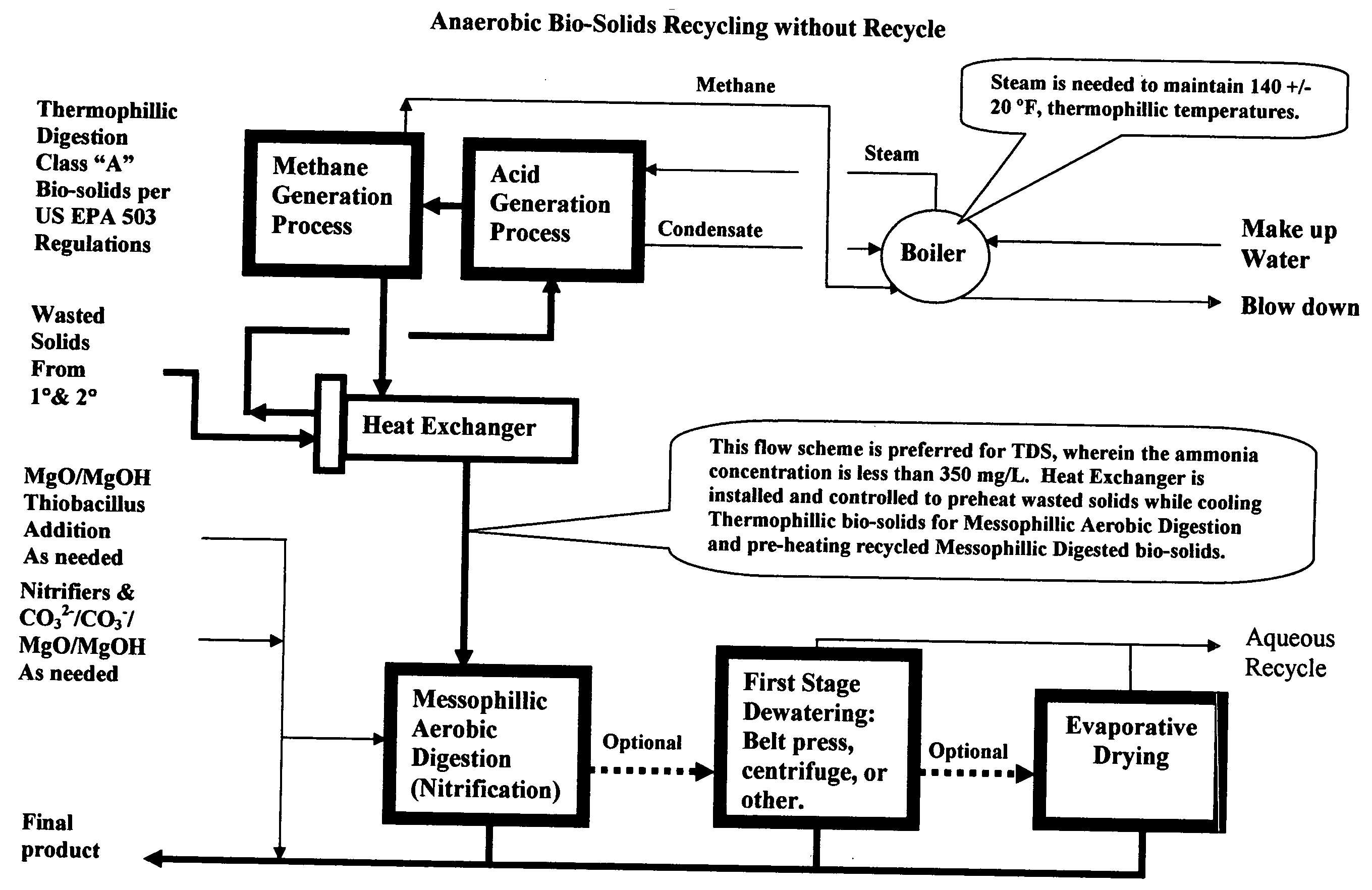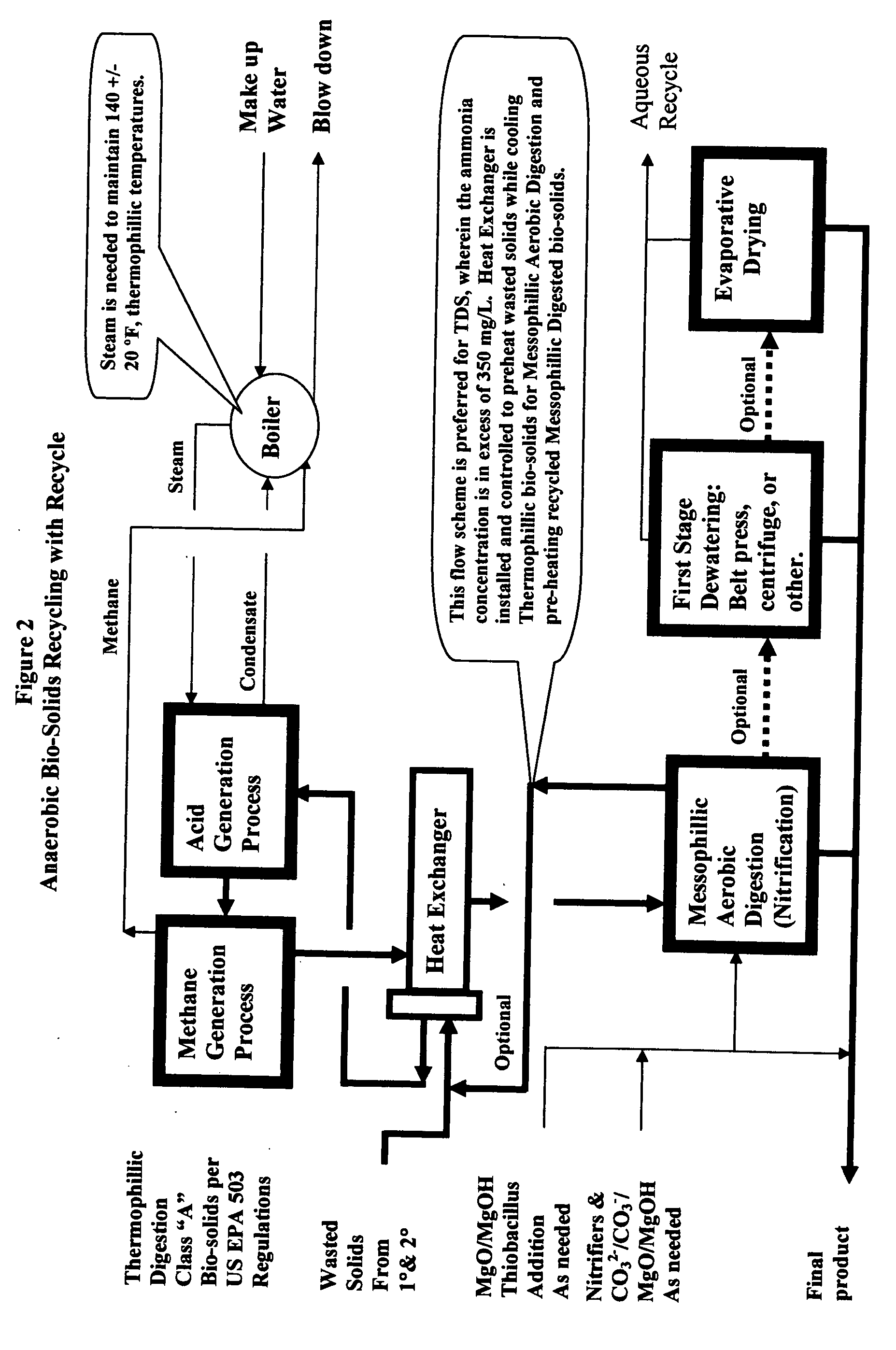Methods, processes and apparatus for bio-solids recycling and the product of bio-solids from such methods, processes and apparatus
a biosolids and process technology, applied in the field of water treatment, can solve the problems of odor and attract pathogen-carrying vectors, direct heating methods are rather expensive, and alkaline ds is not a good fertilizer for land application, and achieves the effect of effective, efficient and economically feasibl
- Summary
- Abstract
- Description
- Claims
- Application Information
AI Technical Summary
Benefits of technology
Problems solved by technology
Method used
Image
Examples
example 1
[0114] On Aug. 02, 2001, a sample was obtained from final aqueous solids cake product of the belt dewatering press in Beaumont, Tex. Cake solid from the belt press dewatering operation are normally near 30 percent. Beaumont operates a messophilic anaerobic digester. The cake solids were utilized in bench scale testing to ascertain whether thiobacillus or magnesium oxide were viable additives to control sulfide odors from the aqueous solids.
[0115] Each sample was prepared, mixed and allowed to sit for 24 hours. After 24 hours, observations were made on the sulfide content of the sludge. Since sulfide(s) have an odor threshold of 2 ppb, an individual smell or olfactory test is deemed to be sufficient. Results of this test are tabulated below.
Odor Control Testing of DSNO.SAMPLEODOR / RESULT1ControlHeavy sulfide odor / no result2 1% MgOSlight sulfide and bran / fair3 5% MgOBran / very good40.5% Bio “S-L”Sour / marginal5 1% MgO + 0.25% Bio “S-L”Musty / fair
example 2
[0116] Based upon completion and revision of several tests, it is determined that blends of S Cultures with nitrifiers are capable of allowing nitrification to occur. During the tests, the goal of the treatment of the wastewater was the achievement of nitrification, by applying co-cultures of the thiobacillus bacteria with various heterotrophs.
[0117] S Cultures blended in concentrations of 25% or more with various heterotrophs form co-cultures which are capable of minimizing sulfide content and to allow nitrification to occur, without application of any nitrifiers.
[0118] BOD removal and nitrification is the operating challenge of a 45-acre pond having 3 MGD of wastewater flow per day in Equine, Ariz. At the onset, the level of sulfide(s) in the wastewater was high enough that nitrification halted. The level of sulfates in the sludge of the bottom of the pond was over 10,000 ppm. Dissolved oxygen had reduced to non-detectable levels in various parts of the pond. Five tons of sodium...
example 3
[0119] A bench test was performed utilizing an electric variable speed beaker stir system, commonly referred to as ajar test. 2000 ppm of CV 3750 (20% active) was added to 500 ml of sludge from a thermophilic digestion. The percentage of solids in the sludge was about 4.4 percent. The beaker was allowed to stir at 120 rpm for 30 seconds. At 30 seconds, the rpm was reduced to 90 and 1500 ppm of CV 5120 in a 0.25 percent solution was added to the beaker. After 15 seconds, the stir speed was slowed to 30 rpm and mixed for another 30 seconds. Large, heavy floc (e.g. with a diameter of at least 4 mm) was formed with a somewhat cloudy supernatant.
PUM
| Property | Measurement | Unit |
|---|---|---|
| concentration | aaaaa | aaaaa |
| concentration | aaaaa | aaaaa |
| temperatures | aaaaa | aaaaa |
Abstract
Description
Claims
Application Information
 Login to View More
Login to View More - R&D
- Intellectual Property
- Life Sciences
- Materials
- Tech Scout
- Unparalleled Data Quality
- Higher Quality Content
- 60% Fewer Hallucinations
Browse by: Latest US Patents, China's latest patents, Technical Efficacy Thesaurus, Application Domain, Technology Topic, Popular Technical Reports.
© 2025 PatSnap. All rights reserved.Legal|Privacy policy|Modern Slavery Act Transparency Statement|Sitemap|About US| Contact US: help@patsnap.com



